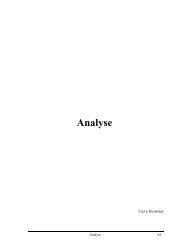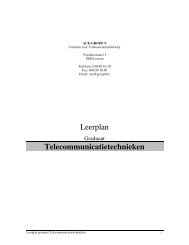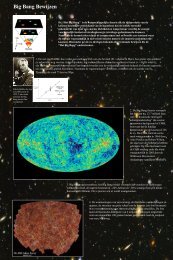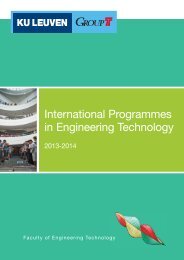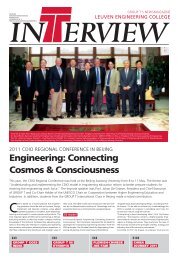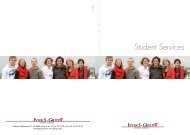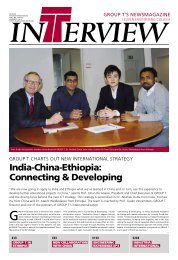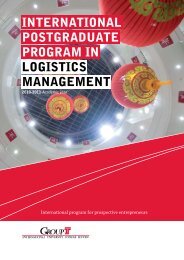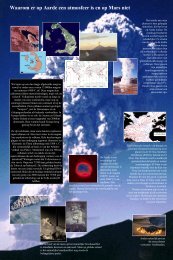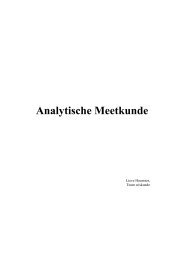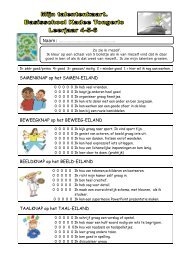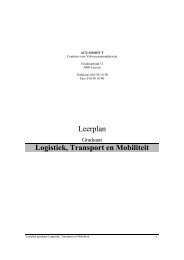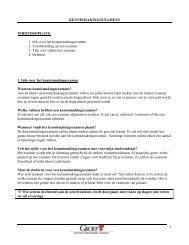Group t and Beijing Jiaotong university open International ... - Groep T
Group t and Beijing Jiaotong university open International ... - Groep T
Group t and Beijing Jiaotong university open International ... - Groep T
Create successful ePaper yourself
Turn your PDF publications into a flip-book with our unique Google optimized e-Paper software.
Erasmus students in the spotlight<br />
Symbol As, atomic number 33<br />
Those who know something about chemistry, know immediately what it is about: arsenic. One of the<br />
most dangerous chemical elements <strong>and</strong> at the same time one of the most common substances in the<br />
earth’s crust. In particular, it can often be found in the groundwater in (too) great concentrations.<br />
Meanwhile, various techniques have been developed to remove the substance from the water although<br />
unfortunately, these cannot be used in all situations. That is why Christiaan Franz <strong>and</strong> Matthias De Rycke,<br />
two Chemistry master’s students at GROUP T went to the University of Calabria, South Italy, with an<br />
Erasmus scholarship to finalize a new purification technique.<br />
The ancient Chinese, Greeks <strong>and</strong> Egyptians<br />
were already familiar with the chemical,<br />
but it would not be until 1250 until the German<br />
(al)chemist Albertus Magnus identified<br />
arsenic as an element for the first time. Only four centuries<br />
later, the element was isolated successfully. The<br />
name itself comes from the Greek ‘arsenikon’ which<br />
translates into ‘yellow pigment’ but in its best known<br />
form arsenic is grey.<br />
“Over time, arsenic was used for many different<br />
things,” Christiaan relates. “In the treatment of<br />
syphilis, as a pesticide in fruit farming, for stuffing<br />
animals, as pigment for paint, <strong>and</strong> so on. Today, too,<br />
arsenic is used a lot in the chemical <strong>and</strong> electronics<br />
industry. Did you know that the extremely toxic<br />
arsenic gas plays an important role in the manufacturing<br />
process of microchips <strong>and</strong> transistors?”<br />
“In any form, arsenic has always had a bad reputation,”<br />
Matthias continues. “Because it was practically<br />
undetectable, arsenic compounds were very<br />
popular for poisoning people. The most well-known<br />
victim is probably Napoleon. After examination at his<br />
place of exile, it turned out that his body contained<br />
large quantities of arsenic. At the time, the finger<br />
was pointed at his English guards. Later, it turned<br />
out that it was not all that extraordinary because, in<br />
Napoleon’s time, people were exposed to 100 times<br />
more than people are these days.”<br />
Membrane technology<br />
Christiaan Franz <strong>and</strong> Matthias<br />
De Rycke went to the University<br />
of Calabria, South Italy.<br />
Back to the present. Early February 2010, Christiaan<br />
<strong>and</strong> Matthias packed their bags for 11 weeks of<br />
research at the University of Calabria. Their supervisor<br />
Prof. Chantal Block had got them ready for it <strong>and</strong> had<br />
taken care of the required contacts. Both master’s students<br />
could go to work at the Institute on Membrane<br />
Technology that was established on the campus.<br />
“Well, we did not exactly leave unprepared,” Christiaan<br />
explains. “In September 2009, we went to prospect<br />
for a week to learn what precisely was expected<br />
of us. Our local co-supervisor provided us with a lot of<br />
material so that we could start studying the literature<br />
thoroughly during the first semester.”<br />
As has already been said, arsenic can be found almost<br />
everywhere in the soil. “The groundwater also contains<br />
arsenic which is dissolved in the soil in the process<br />
of rock erosion,” Matthias clarifies. “The water seeps<br />
into the soil <strong>and</strong> picks up the toxic substance. In countries<br />
like India, Vietnam <strong>and</strong> Bangladesh where millions<br />
of people depend on groundwater with a high<br />
level of arsenic, chronic arsenic poisoning is the order<br />
of the day. Symptoms include skin <strong>and</strong> other cancers,<br />
tumors on bladder, lungs, kidneys, liver, etc.”<br />
Micro spheres<br />
“At the University of Calabria, research has already<br />
been carried out for some time now into how to<br />
remove arsenic from the groundwater using membranes,”<br />
Christiaan continues. “The membranes are<br />
built into large filters that can be deployed at a large<br />
scale. The problem is that poor, rural areas do not<br />
have the means available to use such equipment.<br />
So we opted to approach it on a smaller scale. We<br />
started to make micro spheres based on polymers.<br />
These micro spheres have a 1.5 mm cross section<br />
<strong>and</strong> can be best compared to polystyrene globules.<br />
They act as a carrier of titanium dioxide (TiO 2<br />
for<br />
the experts), a compound that absorbs arsenic. TiO 2<br />
,<br />
in other words, is the active ingredient that draws<br />
out <strong>and</strong> binds the poisonous arsenic like a magnet.<br />
The micro spheres with the TiO 2<br />
are like the tea in<br />
a tea bag.”<br />
“One could indeed just toss the TiO 2<br />
in the water, but<br />
that raises the problem of getting it back out <strong>and</strong><br />
this time with the arsenic included,” Matthias adds.<br />
“This is possible in principle, there are technologies<br />
to do this, only poor regions wouldn’t be able to<br />
afford that. So it is necessary to immobilize the TiO 2<br />
in our micro spheres which are easy to remove <strong>and</strong><br />
can also be recuperated, TiO 2<br />
<strong>and</strong> all. A good wash<br />
in an extremely acidic or alkaline solution suffices to<br />
make it ready for use again.”<br />
<strong>International</strong> critical level<br />
The required tests were carried out in collaboration<br />
with the University of Karlsruhe in Germany. “Successfully,”<br />
says Christiaan. “You have to know that<br />
the World Health Organization sets a critical level of<br />
10 micrograms of arsenic per liter. We are substantially<br />
below that with out polymer capsules. With<br />
5 grams of those micro spheres we can easily purify<br />
50 liters. If you consider that in countries like Bangladesh<br />
it is everyday practice to consume water with<br />
50 micrograms arsenic per liter, it is clear that our<br />
technique can be very useful there.”<br />
An important step in the right direction, in other<br />
words, but it is always possible to do better. Both students<br />
realize this. “The technique can definitely be<br />
perfected further,” Matthias confirms. “For instance,<br />
the polluted water did not yet fully penetrate to the<br />
core of the TiO 2<br />
in the micro sphere. As a result, a<br />
part remains unused. If we succeed in making the<br />
outer part more porous still, the result will be noticeably<br />
better. But that will be up to our successors.”<br />
Italian pace<br />
Of course, an Erasmus student enjoys more than only<br />
laboratory work, although it was only after several<br />
weeks of intensive experiments that Christiaan <strong>and</strong><br />
Matthias were allowed some time off to explore<br />
the region, head to the nearby sea, visit Rome <strong>and</strong><br />
Cosenza <strong>and</strong> of course enjoy the excellent gastronomic<br />
qualities of Southern Italy. “After a while, we<br />
were indeed less stressed <strong>and</strong> got used to the more<br />
easygoing Italian tempo,” Matthias says. To the<br />
extent even that both GROUP T students were asked<br />
to return after their studies to do a Ph.D. in Italy.<br />
There is little chance of that, though. Christiaan prefers<br />
to go study Industrial Management. And Matthias<br />
sees himself in the footsteps of his father: starting<br />
as an independent engineer in the construction<br />
sector. One thing they both agree on: the Erasmus<br />
adventure was certainly not poisoned gift.<br />
Y.P.<br />
GROUP T - LEUVEN ENGINEERING COLLEGE<br />
15<br />
jg. 20, nr. 1, 15 december 2010



